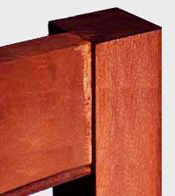


Question: I am new to mortise and tenon joinery. I find when I glue up the joint and clamp it, the glue squeeze-out is very difficult to remove around the edges and leaves a thin film which does not allow the stain or finish to penetrate. How do I clean the glue off those edges effectively?
Answer:
A couple of schools of thought regarding your issue.
The strength of a tenon comes from the longitudinal fibers of the wood glued together. Any end-grain gluing (at the bottom of the tenon or at the shoulders) is not adding any structural strength to the joint. If you avoid gluing around the cheeks, you can better avoid the squeeze-out. Of course, it is natural to want to be sure we are not starving a glue joint and over-apply glue.
I find that when I have excessive glue squeezing out I can create more problems by wiping off the wet glue. If you can get the squeeze-out to just a bead that forms but doesn't run and drip, you can wait 10 - 30 minutes and pare the glue bead off with a sharp chisel. At this point the texture of the glue should be rubbery, not still liquid-wet but not yet hard and brittle.
Wiping off excess glue tends to force the glue down into the grain and then makes it hard to sand all remnants of the glue away.
The "don't disturb and then pare away" method works for me, but only when I don't over-apply the glue. If I am heavy-handed with the glue, I, too, have an excessive glue residue problem. I avoid wiping off the glue unless absolutely necessary. I'll then use a cabinet scraper to scrape away the dried glue. This seems to do a better job than only using sandpaper.
Some folks subscribe to the view that with enough water, you can wipe off the wet glue residue fairly well. On closed-grain woods I've had success with this. On open-grained woods, however, the glue residue still haunts me using this method.
As an aside thought, dried glue is hard on tool steel - it dulls planer and jointer knives (and cabinet scrapers) quickly. When gluing parts up that will be milled, it is advisable to remove the dried glue as much as possible before the stock comes into contact with the knives of the machinery.